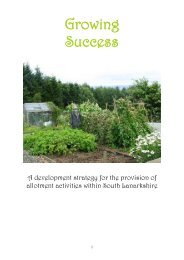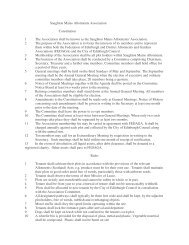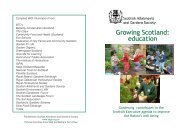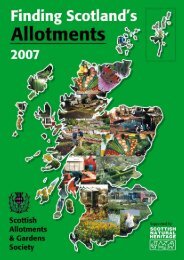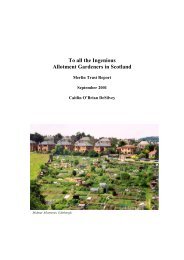Woodend Allotments in Banchory - Scottish Allotments and Gardens ...
Woodend Allotments in Banchory - Scottish Allotments and Gardens ...
Woodend Allotments in Banchory - Scottish Allotments and Gardens ...
Create successful ePaper yourself
Turn your PDF publications into a flip-book with our unique Google optimized e-Paper software.
Creat<strong>in</strong>g community plots - the story of <strong>Woodend</strong> <strong>Allotments</strong><br />
Background<br />
The idea for plots <strong>in</strong> <strong>Banchory</strong> arose from work of <strong>Woodend</strong> Arts Association (WAA), a<br />
volunteer-led community project which was formed [as a registered <strong>Scottish</strong> Charity] <strong>in</strong><br />
1992. WAA runs the <strong>Woodend</strong> Barn Arts Centre <strong>in</strong> <strong>Banchory</strong> <strong>and</strong> organises music,<br />
drama, dance, art <strong>and</strong> craft events <strong>and</strong> workshops (see: www.woodendbarn.co.uk). WAA<br />
has always been <strong>in</strong>terested <strong>in</strong> explor<strong>in</strong>g all aspects of art <strong>and</strong> the arts, <strong>and</strong> there has been<br />
an environmental str<strong>and</strong> to its work s<strong>in</strong>ce 2002 when it helped form the Aberdeenshire<br />
Slow Food Convivium, promot<strong>in</strong>g local, preferably organic, food (see:<br />
www.slowfood.com). In 2003 WAA organised an exhibition by a local artist, Janet<br />
McEwan, called "Waste not, Want not". The exhibition was accompanied by a week<br />
long series of events draw<strong>in</strong>g attention to the wastefulness of our society <strong>and</strong> promot<strong>in</strong>g<br />
less waste <strong>and</strong> more recycl<strong>in</strong>g. ["Waste not, Want not" also <strong>in</strong>volved a poet work<strong>in</strong>g <strong>in</strong><br />
local primary schools over the three weeks ahead of the exhibition culm<strong>in</strong>at<strong>in</strong>g <strong>in</strong> an<br />
exhibition <strong>in</strong> <strong>Banchory</strong> Academy. ]<br />
Discussions <strong>in</strong> 2002/3 around Slow Food, reduc<strong>in</strong>g waste, compost<strong>in</strong>g <strong>and</strong> other such<br />
important issues, led to the idea that we should take more practical steps to promote local<br />
food production. A number of local people helped two local growers establish an organic<br />
farm<strong>in</strong>g bus<strong>in</strong>ess <strong>in</strong> the area <strong>and</strong> promoted a vegetable box scheme <strong>in</strong> <strong>Banchory</strong>. And<br />
WAA held a public meet<strong>in</strong>g at the <strong>Woodend</strong> Barn <strong>in</strong> 2002 to see if there was sufficient<br />
<strong>in</strong>terest to form an <strong>Allotments</strong> group. Six people attended but most were keen gardeners<br />
who already had ground but were <strong>in</strong>terested <strong>in</strong> what we were plann<strong>in</strong>g. With only 2 or 3<br />
<strong>in</strong>terested <strong>in</strong> hav<strong>in</strong>g a plot, <strong>and</strong> fewer <strong>in</strong>terested <strong>in</strong> creat<strong>in</strong>g a new <strong>Allotments</strong> group,<br />
fund-rais<strong>in</strong>g etc, the idea lapsed.<br />
Interest <strong>in</strong> the idea smouldered for two years until two further public meet<strong>in</strong>gs <strong>in</strong> late<br />
2004 <strong>and</strong> early 2005 led to the formation of <strong>Woodend</strong> <strong>Allotments</strong>, a constituted voluntary<br />
group with a committee of six prepared to drive the project forward. The follow<strong>in</strong>g steps<br />
outl<strong>in</strong>e the experience of <strong>Woodend</strong> <strong>Allotments</strong> <strong>and</strong> may be helpful to others plann<strong>in</strong>g a<br />
similar project.<br />
Step 1: f<strong>in</strong>d<strong>in</strong>g some ground . . .<br />
Once you have established the will <strong>and</strong> enthusiasm, you need some ground. WAA lease<br />
the <strong>Woodend</strong> Barn from the Leys Estate [who own much of the l<strong>and</strong> between Crathes <strong>and</strong><br />
<strong>Banchory</strong>]. Leys Estate have always been very supportive of WAA's work <strong>and</strong> they<br />
responded positively to suggestions <strong>in</strong> 2002 that allotment gardens might occupy the field<br />
immediately beh<strong>in</strong>d the <strong>Woodend</strong> Barn.<br />
Step 2: form<strong>in</strong>g a committed group . . .<br />
This step took us several years. By 2004 we had found about a dozen people keen to<br />
work a plot but no-one keen to attend committees <strong>and</strong> fund-raise. By early 2005 six<br />
generous people agreed to brave the donkey-work necessary to form <strong>Woodend</strong><br />
<strong>Allotments</strong> (WA) as a constituted organisation (with elected officers, a bank account etc)<br />
<strong>and</strong> turn the plots <strong>in</strong>to reality.
Step 3: clarify<strong>in</strong>g what you want to do <strong>and</strong> how then to do it . . .<br />
In tune with all activity at <strong>Woodend</strong> Barn, it was decided that we should seek to <strong>in</strong>clude<br />
all parts of the community <strong>in</strong> the plots. This meant keep<strong>in</strong>g rental costs for a plot to<br />
below a pound a week so that no-one was excluded. We also actively sought the<br />
<strong>in</strong>volvement of various local groups <strong>in</strong>clud<strong>in</strong>g schools, the Scolty Centre <strong>and</strong> community<br />
mental health.<br />
How many plots would we cater for? We had about 15 people signed up at this stage <strong>and</strong><br />
thought that 25 plots might be all that would be needed. However, the field available<br />
could easily accommodate at least 36 plots (18m by 9m each) <strong>and</strong> the costs of fenc<strong>in</strong>g,<br />
complications of the Lease <strong>and</strong> plann<strong>in</strong>g permission etc meant that we could not easily<br />
exp<strong>and</strong> the number of plots once we had started. After much discussion, we decided to go<br />
for the whole area available, th<strong>in</strong>k<strong>in</strong>g that we might have to grass half of it for the first<br />
year or two until all plots were taken (as it happened, all plots were taken with<strong>in</strong> a couple<br />
of months of open<strong>in</strong>g).<br />
A budget was drawn up to provide deer <strong>and</strong> rabbit-fenc<strong>in</strong>g, car park<strong>in</strong>g spaces,<br />
community cab<strong>in</strong> <strong>and</strong> shed, <strong>and</strong> hedge plant<strong>in</strong>g. The budget came to an <strong>in</strong>timidat<strong>in</strong>g<br />
£12,000. Given that, once established, there would be ongo<strong>in</strong>g runn<strong>in</strong>g costs, we needed<br />
to fund the capital costs to set up the plots through grants <strong>and</strong> donations. Before apply<strong>in</strong>g<br />
for fund<strong>in</strong>g, we needed to establish rights over the l<strong>and</strong>. Leys Estate were happy to<br />
negotiate a Lease for the field but this was likely to take months as it <strong>in</strong>volved lawyers<br />
etc. To allow us to proceed immediately with the fund-rais<strong>in</strong>g, Leys Estate provided WA<br />
with a letter which agreed the ma<strong>in</strong> terms of the Lease, <strong>in</strong>clud<strong>in</strong>g a 30-year term for the<br />
l<strong>and</strong>.<br />
With WAA advice <strong>and</strong> support, £9,500 was raised from Awards for All <strong>and</strong> £1,500 from<br />
Aberdeenshire Council via the Marr Area Partnership (MAP) dur<strong>in</strong>g 2006. In addition,<br />
British Gas generously funded a communal shed. The balance of the budget would be<br />
provided by voluntary labour, borrow<strong>in</strong>g skills <strong>and</strong> equipment where necessary.<br />
Step 4: Deal<strong>in</strong>g with the adm<strong>in</strong>istration. Sadly, you're not immune from legal <strong>and</strong> account<strong>in</strong>g<br />
requirements just because you're a "not for profit" organisation. HM Revenue & Customs provide<br />
some very useful guidance for small clubs <strong>and</strong> societies at:<br />
http://www.hmrc.gov.uk/guidance/clubs-societies.htm You also need to deal with matters such<br />
as <strong>in</strong>surance. If you can co-opt people who have experience of runn<strong>in</strong>g bus<strong>in</strong>esses <strong>and</strong>/or other<br />
small clubs onto the committee then so much the better.<br />
Step 5: preparations for the plots . . .<br />
Dur<strong>in</strong>g 2006, <strong>in</strong> parallel with negotiat<strong>in</strong>g the Lease, we had several meet<strong>in</strong>gs with the<br />
local plann<strong>in</strong>g authority. To our surprise, we needed plann<strong>in</strong>g permission to change the<br />
use of the field from agriculture to horticulture. The planners were keen on the idea of<br />
allotments <strong>and</strong> generally very helpful, but this was still a time-consum<strong>in</strong>g <strong>and</strong> sometimes<br />
frustrat<strong>in</strong>g process. I th<strong>in</strong>k we were the first application for allotments that Aberdeenshire<br />
planners had ever seen, so hopefully future applications will be easier for everyone
concerned. As part of the plann<strong>in</strong>g application, we wrote a Development Brief (govern<strong>in</strong>g<br />
size of plots, sheds permitted, storage issues, hedges etc) <strong>and</strong> a Ma<strong>in</strong>tenance Brief<br />
(govern<strong>in</strong>g how the site would be managed <strong>and</strong> ma<strong>in</strong>ta<strong>in</strong>ed).<br />
Dur<strong>in</strong>g 2006 we also obta<strong>in</strong>ed various quotations for the fenc<strong>in</strong>g <strong>and</strong> other works. We<br />
discovered that every topic has its important <strong>in</strong>tricacies.....exactly what sort of fenc<strong>in</strong>g?<br />
what spac<strong>in</strong>g of fence posts? what sort of gates? closure mechanisms? locks? what sort of<br />
sheds? how big/tall? what colour? what services? what sort of car park? what material?<br />
how dra<strong>in</strong>ed? <strong>and</strong> so on. Our committee have become quite knowledgeable about a range<br />
of subjects!<br />
Hav<strong>in</strong>g l<strong>in</strong>ed up all the contractors/suppliers, we found we still did not quite have the<br />
plann<strong>in</strong>g permission, but it would be com<strong>in</strong>g imm<strong>in</strong>ently . . .<br />
Step 6: runn<strong>in</strong>g a small construction project . . .<br />
Many books have been written on this subject....save to say here that you need one<br />
'project manager' who has experience of runn<strong>in</strong>g a project, is a team player <strong>and</strong> is sighted<br />
on all aspects of the project. Even given all the right skills, which are rarely available,<br />
there is still the challenge of try<strong>in</strong>g to get different elements of the work done at the right<br />
time.<br />
For all sorts of reasons, our deer <strong>and</strong> rabbit-proof fence arrived 3 months after the plots<br />
opened (no-one wanted to defer the April 2007 open<strong>in</strong>g). So potatoes were very popular<br />
to beg<strong>in</strong> with <strong>and</strong> when the fence arrived, we had a rabbit-clear<strong>in</strong>g project. 15 plotholders<br />
<strong>and</strong> friends, 5 dogs <strong>and</strong> three ferrets (to get under sheds) were ga<strong>in</strong>fully employed<br />
for a couple of hours driv<strong>in</strong>g rabbits out of the plots.<br />
Another Step 6: sign<strong>in</strong>g up all your plot-holders . . .<br />
In parallel with the project work, we drafted a Plot-holders' Tenancy Agreement that each<br />
plot-holder could sign as a contract with WA. This details all the rights <strong>and</strong> obligations<br />
of the plot-holder <strong>and</strong> l<strong>in</strong>ks to our Lease for the l<strong>and</strong> (<strong>in</strong> effect, the plot-holders are subtenants).<br />
We used a model from the web: http://www.bidefordtown.co.uk/<strong>Allotments</strong>.html <strong>and</strong><br />
adapted it for a private agreement (i.e. remov<strong>in</strong>g all references to Councils <strong>and</strong> various public<br />
Acts). Anyone contemplat<strong>in</strong>g sett<strong>in</strong>g up allotments should spend some hours on the web -<br />
there is a huge amount of useful <strong>in</strong>formation <strong>and</strong> experience freely available. To start<br />
with, try: www.sags.org.uk/, www.nsalg.org.uk/, www.allotment.org.uk/<br />
Step 7: digg<strong>in</strong>g <strong>and</strong> plant<strong>in</strong>g . . .<br />
We sometimes thought we'd never get to this bit. It's hard work but great fun . . . but do<br />
all allotments have to have couch grass? <strong>and</strong> slugs? <strong>and</strong> potato blight just because it ra<strong>in</strong>s<br />
for most of June <strong>and</strong> July ?<br />
Postscript:<br />
All the plots at <strong>Woodend</strong> Barn have been allocated <strong>and</strong> there is currently a wait<strong>in</strong>g list. If<br />
you would like to jo<strong>in</strong> the wait<strong>in</strong>g list, e-mail mark@woodendbarn.co.uk<br />
MH/13/8/2007



